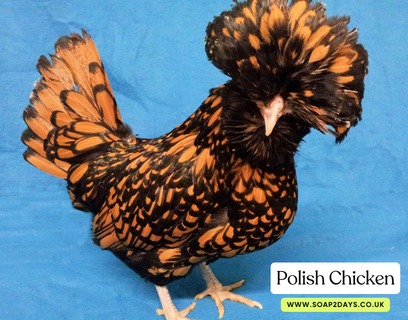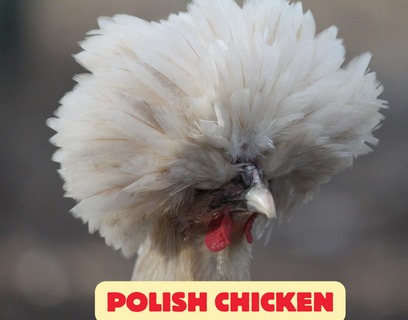The Polish chicken is a truly unique and captivating species, known for its distinctive crest of feathers on top of its head. This article studies the Polish chicken, a bird of the bantam variety, excavating into its history, characteristics, care, and temperaments, and providing useful tips for proper nurture.

Understanding the Polish Chicken Breed
What’s the History behind the Polish Chicken
The history of the Polish chicken, acknowledged by the American Fowl Association, dates back to ancient times, with roots traced back to Poland. Initially treasured for both their ornamental and practical purposes, Polish chickens, including the non-bearded variety, were kept by Polish soldiers in the 16th century to sustain their livelihood. Earning a place in the Standard of Perfection, the Polish chicken has soared to prominence for its unique attire and friendly approach to humans.
Varieties of Polish Chickens
Polish chickens come in a wide variety of colors and feather patterns, including white crested black, white crested blue, buff laced, and silver laced, among others. The vibrant color patterns in combination with a striking wattle make the Polish chickens distinct and appealing, enticing fowl enthusiasts globally.
Feather Characteristics of Polish Chickens
The most striking feature of Polish chickens is their crest of feathers, which gives them an elegant and regal appearance. Their feathers may come in various patterns and colors, making them a popular choice for those seeking unique and visually appealing birds for their flock.
Exploring the Temperament of Polish Chickens
Behavioral Traits in Polish Chickens
Polish chickens, known to go broody infrequently, are loved for their friendly and docile nature, making them an impeccable addition to any flock. However, they can be somewhat flighty due to their impaired vision caused by their head feathers, which should be taken into consideration when caring for them.
Handling and Care Tips for Polish Roosters
When caring for Polish roosters, it’s essential to provide them with a safe and secure environment where they can roam freely without feeling threatened. Additionally, regular trimming of their head feathers may be necessary to improve their visibility and overall well-being.
Managing a Flock of Polish Chickens
When managing a flock of Polish chickens, especially the bearded ones, it’s important to establish a distinguishable pecking order and ensure each bird has sufficient space to roost comfortably. Additionally, providing enriching activities and a well-maintained coop can contribute to the overall harmony and contentment of the flock.
Polish Chicken Care Guide
Setting Up the Coop for Polish Chickens
When setting up a coop for bantam Polish chickens, it’s important to create a secure, ample environment that provides safeguarding from predators and adverse weather scenarios. Additionally, ensuring adequate ventilation and access to natural light is essential for their overall well-being.
Egg Production and Broodiness in Polish Hens Breed
Polish hens are known for their consistent egg production, providing a steady supply of white eggs throughout the year. However, it’s essential to monitor their broodiness and provide appropriate nesting spaces for their comfort and the successful hatching of eggs.
Feeding and Care for Laced Polish Chickens
Laced Polish chickens, especially the non-bearded ones, require a balanced and nutritious diet to uphold their health and vitality. Providing a mix of grains, seeds, and quality fowl feed, along with access to clean water and grit, is essential for their overall well-being.
The Beauty of Crested Polish Chickens
Distinctive Traits of Crested Polish Chickens
Crested Polish chickens are renowned for their elegant appearance and striking head feathers. Their distinctive crest and vibrant color patterns make them an attractive choice for those seeking ornamental or backyard chickens.
Grooming and Maintenance of Crested Plumage
To maintain the beauty of their crested plumage, regular grooming, and gentle cleaning may be necessary to keep their feathers in pristine condition. Additionally, providing ample opportunities for dust bathing can contribute to their overall grooming and maintenance needs.
Polish Chickens as Ornamental or Backyard Chickens breed
Whether kept for ornamental purposes or as backyard chickens, Polish chickens are a delightful and visually appealing addition to any poultry enthusiast’s collection. Their graceful appearance and friendly demeanor make them popular for those seeking unique and captivating birds.

Health and Wellness of Polish Chickens
Recognizing and Managing Common Health Issues
Polish chickens may be susceptible to common health issues, such as respiratory infections or mite infestations. Regular health checks, access to clean living conditions, and a nutritious diet can help prevent and manage these health concerns effectively.
Creating a Comfortable Environment for Polish Chickens
Providing a comfortable and enriching environment for Polish chickens is crucial for their overall well-being. This includes offering ample space for exercise, access to fresh water and nutritious food, and protection from extreme weather conditions and predators.
Consulting a Poultry Breeder for Polish Chicken Care
For those new to caring for Polish chickens or seeking professional advice, consulting a reputable poultry breeder or veterinarian can provide valuable insights and guidance to ensure the optimal care and well-being of these remarkable birds.
FAQS:
How big do they get?
Polish chickens typically grow to be between 8 and 12 inches tall when fully grown.
Are they good layers?
Yes, Polish chickens are excellent egg layers and produce up to 200 eggs per year if cared for properly! This makes them an ideal choice for those looking to raise backyard chickens or start their own small farm business.
Do they need special care?
No, not necessarily – as long as you provide your birds with adequate food, water, shelter, and protection from predators then they should thrive without any additional effort required from you! However, it’s always important to check on them regularly just to make sure everything is okay and there aren’t any health issues developing that may require medical attention sooner rather than later (such as mites).
Are Polish hens friendly towards humans?
Yes – generally speaking, polish hens tend to be quite docile creatures who have no problem being handled by people once accustomed enough! As such, this makes them great pets even if one doesn’t plan on raising chicks anytime soon!
Do I need more than one hen?
It depends – if you want your hen(s)to lay eggs consistently then yes, multiple hens would be beneficial however single ones can still live happily alone provided ample space & stimulation!
How much space does each bird need?
Each bird needs roughly 4 square feet of floor area within its enclosure so ensure whatever housing option chosen provides sufficient amounts before bringing home new feathered friends!
Can I free-range my Polish hens?
Absolutely – although it’s recommended only doing so under supervision given potential dangers posed outdoors like hawks & other predatory animals lurking nearby waiting to pounce upon unsuspecting prey items. Not exactly what we’d wish our beloved pet birds experience right?!
What type of feed should I give my Polish hens?
A balanced diet consisting primarily of grains supplemented with occasionally fresh fruits/vegetables along with occasional treats like mealworms all help maintain optimal nutrition levels necessary to keep healthy happy members family 🙂
Conclusion:
Caring for a Polish chicken requires dedication but brings immense rewards both physically and emotionally; whether planning use solely for ornamental purposes or wanting to reap benefits laying eggs either way taking proper steps ensure longevity and well-being is greatly appreciated by feathered friend alike 😉
